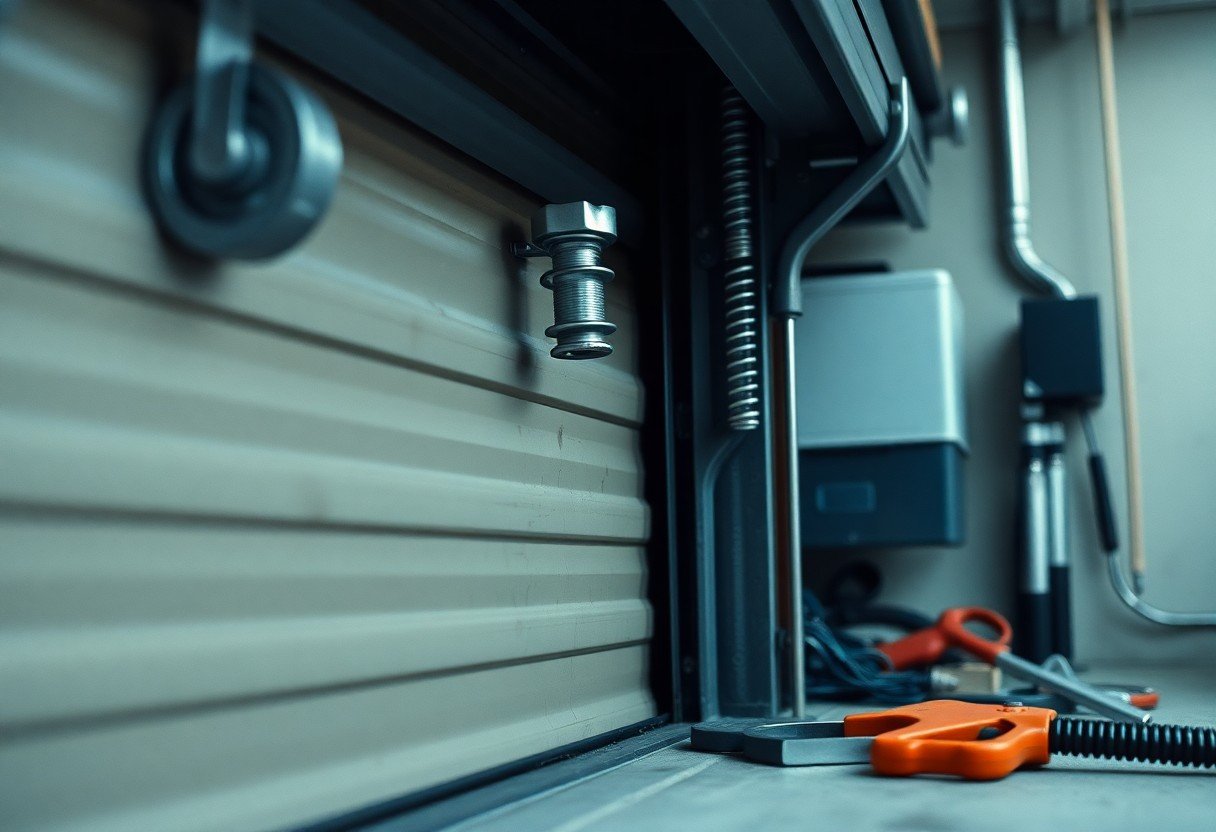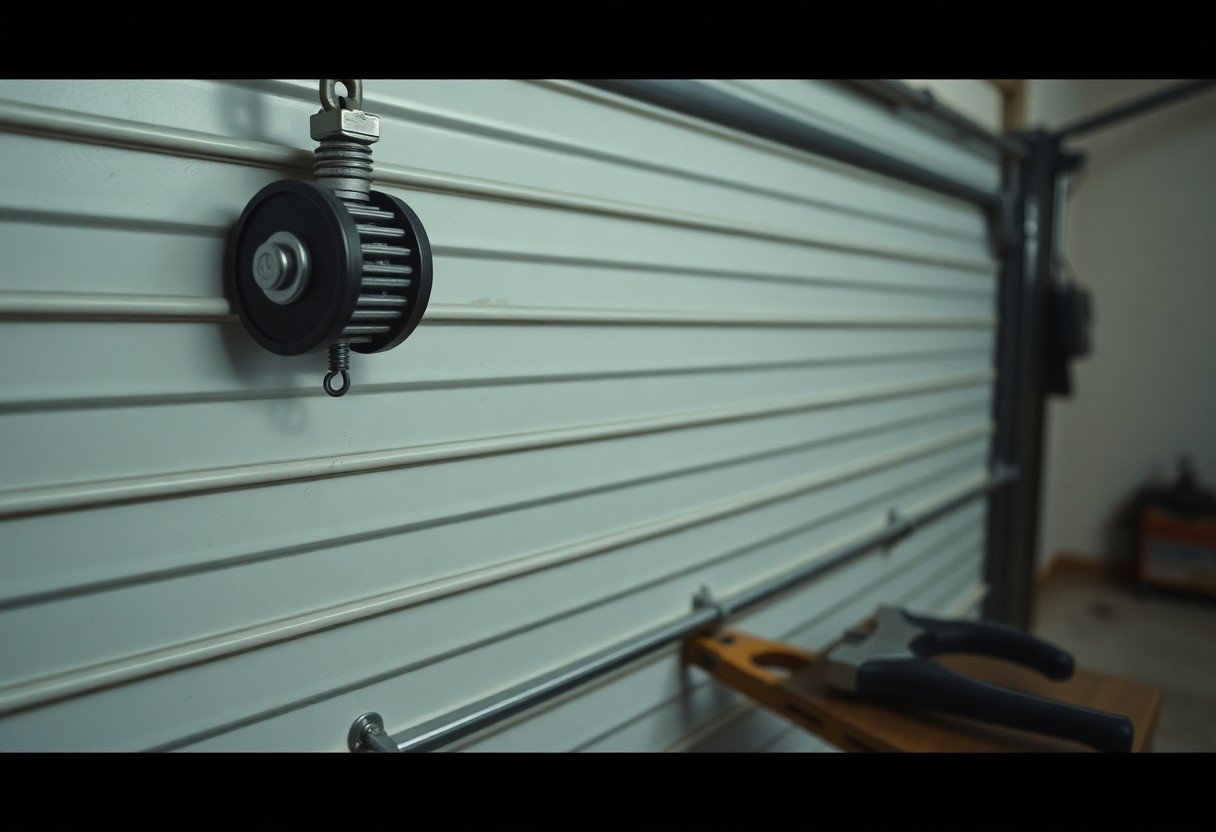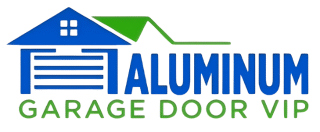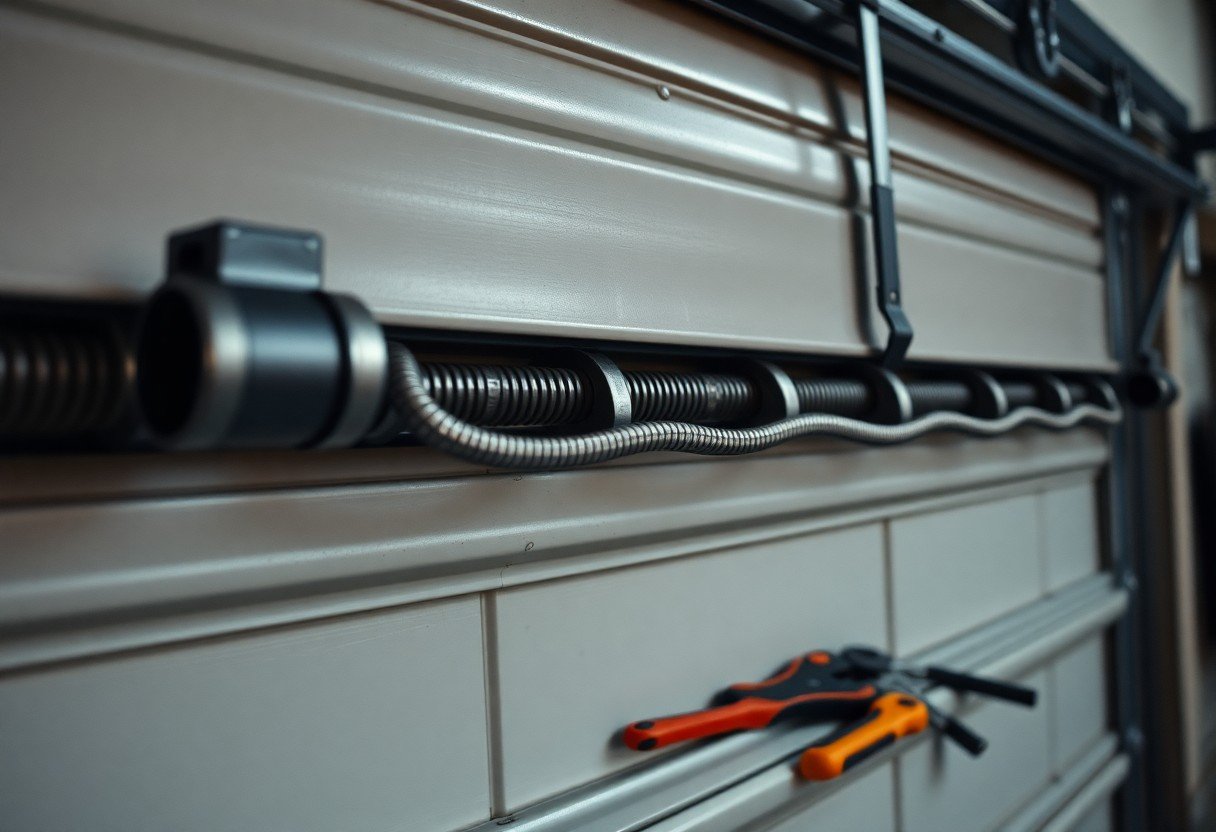
Why Your Garage Door Is Making Noise (And How to Fix It)
Most homeowners have experienced that unsettling sound coming from their garage door, making you wonder what’s wrong. Whether it’s squeaks, grinding, or rattling, these noises can indicate underlying issues that may require your attention. In this guide, we’ll explore the common causes of noise in garage doors and provide practical solutions to help you restore peace and quiet to your home. Get ready to uncover the reasons behind the racket and learn how to fix it like a pro!
Key Takeaways:
- Common causes of noise in garage doors include worn-out rollers, damaged or loose hardware, and lack of lubrication.
- Routine maintenance, such as lubricating moving parts and tightening loose components, can significantly reduce noise levels.
- If noises persist despite maintenance efforts, it may be necessary to consult a professional for further inspection and repairs.

The Origins of Garage Door Noises
Identifying Common Sounds and Their Causes
As you listen to your garage door, various sounds may emerge, each signaling a different issue. For instance, a scraping noise often indicates that the door is off track, while a squeaking sound is typically associated with worn-out rollers or lack of lubrication. Meanwhile, a thud can suggest that your door is misaligned or that components need tightening. Pinpointing these sounds allows you to address issues more efficiently before they escalate.
The Role of Garage Door Components in Noise Production
Your garage door’s components play a significant role in the noises it produces as it operates. Over time, parts like springs, rollers, and tracks can wear down, causing increased friction and noise during movement. For instance, unlubricated rollers can become noisy and impede the smooth operation of the door. Likewise, loose hardware can lead to rattling sounds, while malfunctioning sensors may create beeping noises. Understanding these components helps you maintain your door’s functionality and reduce unnecessary racket.
The springs, tracks, rollers, and motor are imperative components of your garage door system, each contributing to the overall sounds produced during operation. Springs can create tension or rattling noises when they are worn or improperly installed, while the tracks may emit scraping sounds if there is an obstruction. Rollers, particularly if damaged or unlubricated, can produce an irritating squeaking sound. Regular maintenance and inspections are vital to ensure these components function correctly, helping you avoid disruptive noises in the future. For tips on handling these issues, check out How to Fix Your Noisy Garage Door – Do’s & Dont’s.
Assessing the Severity of the Issue
Determining If It’s a Minor Annoyance or a Major Concern
Deciphering whether the noise from your garage door is a minor irritation or an indication of a serious problem can save you time and money. If the sound is a soft rattling or gentle squeaking, it’s likely just a matter of lubrication or loose hardware. However, loud bangs, grinding, or an alarming clunking usually suggest that you might be facing an underlying mechanical issue, such as worn-out rollers or misaligned tracks. Taking these noises seriously can help you avoid further complications down the road.
Tools for Diagnosing Garage Door Problems
Equipping yourself with the right tools can make diagnosing garage door issues much simpler. A basic toolkit—featuring screwdrivers, wrenches, and pliers—can help you tighten loose bolts or adjust misaligned components. A spray lubricant and a cleaning cloth will go a long way in maintaining rollers and hinges, while a level is useful for checking the door’s alignment. A multimeter can further assist in troubleshooting electronic components, particularly if the noise correlates with your garage door opener’s operation.
Using these tools, you can methodically inspect your garage door system. For instance, if you hear noise while opening or closing the door, checking the alignment of the tracks with a level can immediately indicate if an adjustment is needed. If you notice excessive wear or rust on rollers, addressing those components may cut down on noise and extend the lifespan of your garage door. Regular assessments of these elements can help keep issues like these from escalating into significant repairs.

Lubrication: Your First Line of Defense
Recommended Lubricants for Garage Doors
For effective lubrication, opt for silicone spray, lithium grease, or garage door-specific lubricants. Silicone spray provides a long-lasting, protective barrier and is ideal for metal components. Lithium grease, on the other hand, excels in heavy-duty applications as it clings to surfaces and withstands high pressure. For best results, look for products formulated explicitly for garage doors to ensure compatibility with various materials.
Best Practices for Applying Lubrication
Before you start lubricating, clean the door’s moving parts. Wipe off any dust, dirt, or old lubricant to ensure the new application adheres effectively. Apply your chosen lubricant directly to the hinges, rollers, and tracks, avoiding excess that could attract dirt. A light coat is usually sufficient; you’re aiming for smoother operation, not drowning components in grease.
After applying the lubricant, operate your garage door a few times to help distribute the product evenly across moving parts. This motion will assist in breaking down any remaining grime while ensuring the lubricant penetrates every nook and cranny. Regular maintenance, ideally every six months, will prolong the lifespan of your garage door and reduce noise significantly. Keep a checklist of your lubrication schedule to make this task part of your routine, and enjoy a quieter, more efficient garage door operation.

Hardware Check: Fasteners and Hinges
Examining the hardware of your garage door specifically its fasteners and hinges, is a vital step in diagnosing and resolving noise issues. Over time, these components may loosen due to constant movement, causing vibrations that result in clanking or squeaking sounds. Ensure all bolts, screws, and nuts are securely tightened. Pay particular attention to hinges, as worn or rusted ones may require replacement for optimal door operation.
Recognizing Signs of Wear and Tear
Inspect hinges, bolts, and rails for any signs of rust or corrosion. If you notice that any fasteners are cracked, missing, or significantly worn down, it’s time to consider replacements. Additionally, squeaking or grinding noises when operating the door can indicate that hinges are losing their integrity and need attention.
How to Tighten or Replace Loose Components
Tightening loose components is often a straightforward task. Start with a wrench or screwdriver to tighten any loose bolts or screws on the fasteners and hinges. If you find that a particular component is damaged or doesn’t hold tightly after tightening, replacement might be necessary. Ensure you have the correct replacement parts on hand to restore the door’s functionality fully.
To tighten or replace loose components, gather your tools, including a socket wrench set and a screwdriver. Begin by closing your garage door fully and inspecting each fastener visually. For those that feel loose, apply consistent pressure while tightening. If any hinges are rusted or significantly deteriorated, detach them using your tools, and replace them with new, compatible hinges. Always check the manufacturer’s specifications to ensure you select the appropriate size and style. For more detailed guidance on noise troubleshooting, refer to this helpful article on Troubleshoot Your Noisy Garage Door by Type of Noise.
The Importance of Proper Alignment
Misalignment can lead to more than just noise; it can also impact the safety and functionality of your garage door. An aligned garage door ensures smooth operation, preventing potential wear and tear on the mechanism. A misaligned door may lead to difficulties in opening and closing, causing unnecessary wear on the opener and other components. For additional insights, visit our Noisy Garage Doors | Troubleshooting Guide.
Identifying Misalignment Issues in Garage Doors
You can spot misalignment by observing your garage door during operation. If it doesn’t sit evenly in its tracks or makes grinding or scraping noises, it’s likely misaligned. Take a close look at the roller tracks for any bends or obstructions, and watch for gaps or unevenness when the door is closed.
Step-by-Step Guide to Realigning Your Garage Door
Fixing misalignment isn’t complicated, and with a few tools, you can often handle it yourself. Start by disconnecting the garage door opener and manually raising the door to see how it operates. Check the alignment of the tracks, and if you notice any bends or misalignment, you can gently tap them back into place using a rubber mallet. Use a level to ensure the tracks are vertically aligned, making adjustments as needed. Here’s a helpful breakdown:
Tools You’ll Need | Steps to Follow
— | —
Rubber mallet | Disconnect the opener
Level | Raise the door manually
Wrench | Inspect track alignment
Screwdriver | Adjust and secure track position
To further explain the process, first, ensure the door is in the closed position and disconnected from the opener. Use a rubber mallet to tap areas of the track that appear bent, ensuring gentle pressure to avoid damage. After adjustments, use a level to verify that both tracks are perfectly aligned. Lastly, tighten any mounting hardware using a wrench or screwdriver to secure everything in place. A well-aligned garage door behaves predictably, illuminating safety and efficiency aspects you rely on.
When to Seek Professional Help
Recognizing Complex Issues Beyond DIY Repair
If your garage door is experiencing recurrent issues despite your efforts to resolve them, it might indicate a deeper mechanical problem. Problems such as broken springs, damaged tracks, or malfunctioning openers often require expert intervention. These components are not only complicated but can also pose safety risks if not handled correctly. Understanding when a situation exceeds your DIY capabilities is vital for both the longevity of your door and your safety.
Finding the Right Garage Door Technician
Selecting a qualified garage door technician can make a significant difference in the repair outcomes. Look for technicians with solid experience and positive customer reviews. Certifications from respected organizations within the garage door industry also indicate a commitment to quality work and knowledge of safety standards. It’s beneficial to obtain multiple quotes and inquire about warranty options to ensure you receive satisfactory service.
A reputable technician should offer transparent communication about the diagnosis and repair process. Ask about their previous work and if they have experience handling your specific type of garage door. Your technician should be willing to explain their findings and provide a breakdown of costs before commencing any repairs. This approach not only safeguards your investment but also builds trust in the service being provided.
Preventative Maintenance for Longevity
Recommended Maintenance Schedule for Garage Doors
Establishing a maintenance schedule for your garage door ensures it remains in peak condition. Inspect the door’s hardware, tracks, and rollers every six months for any wear or damage. Every year, perform a thorough cleaning and lubrication of moving parts, and check the balance of the door by disconnecting the opener and lifting it manually to see if it stays in place. Routine checks help you catch issues before they become costly problems.
Tips for Keeping Your Garage Door Quiet
Reducing the noise from your garage door requires a few straightforward strategies. First, periodically check and tighten any loose screws or bolts throughout the door and its components, as vibrations can create unwanted sounds. Keeping the tracks clean and free of debris also minimizes noise during operation. Installing sound-absorbing materials inside the garage can further dampen any excessive sounds. This may create a more peaceful environment in your garage space.
- Lubricate moving parts regularly to minimize friction noise.
- Replace worn rollers and hinges for smoother operation.
- Install insulation to help muffle sounds.
Addressing the little things can go a long way in keeping your garage door quiet. Check the spring tension, as too much tension can create excessive noise during operation. Additionally, consider upgrading to quieter components, such as nylon rollers instead of metal ones, which can significantly reduce the clanking sounds associated with opening and closing your door. This ensures a smoother experience for you and your family every time you use it.
- Check for worn-out springs that can increase noise.
- Install rubber pads on the door’s frame to absorb sound.
- Visually inspect the opener for any loose connections.
A Sound Investment: Upgrading Your Garage Door
When Modification Is Worth the Investment
Investing in a new garage door becomes justifiable when frequent repairs and noise consistently disrupt your peace. If your door is over a decade old, chances are it’s clattering more than it should. The cost of upgrading may outweigh the constant maintenance fees, especially as modern doors come equipped with enhanced insulation and energy efficiency, contributing to long-term savings on your utility bills.
Innovations in Quiet Garage Door Technology
Modern advancements have introduced quiet garage door options designed to minimize noise significantly. Features such as belt-driven openers and insulated panels not only reduce sound but enhance your home’s energy efficiency. Additionally, premium rollers made from durable materials like nylon help diminish friction and vibration, keeping noise levels low, even during operation.
For example, the latest belt-driven garage door openers operate on a smooth, silent mechanism that eliminates the traditional clanking sound associated with chain-driven models. Manufacturers like Chamberlain and LiftMaster have made strides in integrating soft-start technologies, which gradually ease the door into motion, drastically reducing noise levels. Moreover, the use of insulated doors adds a layer of soundproofing, creating a serene atmosphere in adjoining living spaces. With these innovations, investing in a quieter garage door not only enhances your home’s comfort but also contributes to a modern aesthetic appeal.
Summing up
As a reminder, understanding why your garage door is making noise can help you maintain its functionality and extend its lifespan. Factors like worn-out rollers, loose hardware, or a lack of lubrication often contribute to these sounds. By addressing these issues promptly—through regular maintenance or professional help—you can enjoy a quieter, more reliable garage door. This not only enhances your home’s comfort but also ensures safety and security for your belongings.
FAQ
Q: What are the common reasons for a garage door making noise?
A: There are several common reasons why your garage door may be making noise. One of the most frequent causes is worn-out rollers, which can create a grinding or screeching noise as they move along the track. Additionally, loose hardware, such as bolts and screws, can cause rattling sounds. Another possibility is a lack of lubrication on the moving parts, which can lead to squeaking or squealing sounds. Lastly, the garage door opener itself might be generating noise due to wear and tear or misalignment.
Q: How can I fix a noisy garage door?
A: To address a noisy garage door, start with a thorough inspection of all moving parts. Check the rollers for wear and replace them if necessary. Tighten any loose hardware components such as bolts and brackets. Next, lubricate the tracks, rollers, and hinges with a silicone-based lubricant or garage door lubricant to reduce friction and noise. If the garage door opener is the source of the noise, check its alignment and condition, and consider calling a professional if you are unsure about making adjustments yourself.
Q: When should I call a professional for my noisy garage door?
A: It’s a good idea to call a professional if you notice persistent or worsening noise after performing basic maintenance, such as lubrication and tightening hardware. Additionally, if you hear loud banging or clattering noises, it may indicate a more serious issue, such as a broken spring or malfunctioning opener that requires specialized tools and expertise to repair. Always prioritize safety and do not hesitate to reach out to a qualified garage door technician if you’re unsure about handling the situation on your own.



